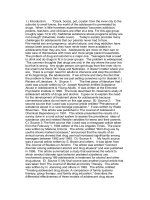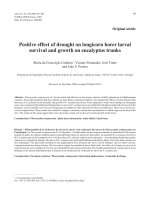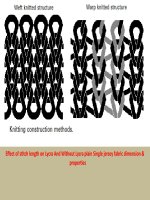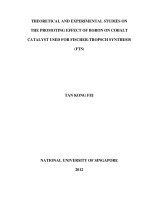Effect of different host on quantitative and qualitative soluble protein of H. armigera
Bạn đang xem bản rút gọn của tài liệu. Xem và tải ngay bản đầy đủ của tài liệu tại đây (345.87 KB, 7 trang )
Int.J.Curr.Microbiol.App.Sci (2019) 8(2): 2495-2501
International Journal of Current Microbiology and Applied Sciences
ISSN: 2319-7706 Volume 8 Number 02 (2019)
Journal homepage:
Original Research Article
/>
Effect of Different Host on Quantitative and Qualitative
Soluble Protein of H. armigera
Prerna B. Chikte1*, Makarand P. Shinde1 and Manjusha S. Gaikwad2
1
Agriculture Technology Information Centre, Dr. PDKV, Akola, India
2
College of Agriculture, Dr. PDKV, Akola, India
*Corresponding author
ABSTRACT
Keywords
H. armigera, Whole
body Homogenate
(WBH), Isoform,
Supernatent,
Electophoretogram,
Dr. Panjabrao
Deshmukh Krishi
Vidyapeeth
Article Info
Accepted:
18 January 2019
Available Online:
10 February 2019
An insight to biochemical nature of target pest, H. armigera is a prerequisite for
an effective management system using natural product, especially against a pest
with a wide host range. The present investigation carried out in laboratory to
assess the influence of different host on qualitative and quantitative protein of H.
armigera, revealed that the host pigeon pea has been the most suitable one for
growth and development test insect, followed by artificial diet, chick pea and the
least preferred being cotton. Considering soluble protein content in insect was
variable in different tissues of H. armigera, samples were taken from whole body
homogenate, haemolymph and midgut. The maximum induction of gut protein
was observed in pigeon pea reared H. armigera, found to be a good inducer of
protein having as well as the higher bands in haemolymph as compare to other,
whereas cotton showed weak impression of protein.
besides being active round the year depending
upon the season and food plants.
Introduction
H. armigera (Hubner) is one of the most
dominant insect in agriculture, Puri 1995[1].
Raheja, 1996 [2] reported that the problem of
pests magnified due to its attack fruiting
structure voracious feeding habits, high
mobility
and
fecundity,
multivoltine,
overlapping generation with facultative
diapause, nocturnal behaviour, migration host
selection and propensity for acquiring
resistance against wide range of insecticides
It has been observed that the type of food, the
insect feeds upon affects the growth,
development and reproduction of insects. The
biological attributes of H. armigera on several
hosts including pigeon pea, maize, sorghum,
cotton, chick pea, safflower and many other
host plants have been studied by Bhagat and
Bhalani, 1994 [3]; Sujalata Devi and Singh,
2004 [4]. Amar and Sayed (2014) [5] studied the
2495
Int.J.Curr.Microbiol.App.Sci (2019) 8(2): 2495-2501
effect of different host plants and artificial
diet on growth and development of H.
armigera. The developmental periods of the
larvae were found shortest on pea and
artificial diet and longest on cotton seed
extensively support the present study.
Bilpate in 1989 [6] reported that the food plant
significantly affect the growth, survival and
reproduction of H. armigera. The larval
development was found to be fast on maize
and slowest on cotton. It has been reported
that, the pest population or even individuals
within the population have often possessed
distinctive properties with respect to crop
hosts. Claridge in 1989 [7] reported that this
system solely depends on the understanding
of interaction between pest population and
their hosts.
Until 1980’s the control of pests dependent on
the broad spectrum chemicals and hence it
was not required to analyse the variation
within and between pest population.
However, an early development of resistance
to chemical pesticides has forced to applied
biologist to understand the nature and
evaluation of such phenomenon. These
investigation
planned
to
study the
biochemical analysis in terms of protein
content of H. armigera showing different
expression in the insect reared on different
hosts can found useful in induction of
immunity in the plants as well as in
suppression of pest programme.
pea, chick pea, artificial diet and cotton. The
estimation of soluble protein was done from
whole body homogenate, mid gut,
haemolymph in the insect reared on different
host by Bradford[7].
The third instar larvae were separated and
starved for 7-8 Hrs. to remove all digested
food particles. The whole larvae and gut
homogenised separately using Sodium
Phosphate buffer.
The WBH and gut obtained was centrifuged
at 10000 RPM for 15 minutes at 40C. The
debris and cellular matter discarded and
supernatant obtained was stored at -200C and
used as protein source for electrophoresis.
For quantitative estimation of protein 5 ml of
sample added in the well of microplate. Then
0.15 N NaCl solution were added in this wells
and 200 ml of Bradford reagent loaded in
each well and incubation was carried out for
15 min. at room temperature. Absorbance was
read in microplate reader equipped with 600
nm. Concentration of protein from
haemolymph,
gut
and whole body
homogenate from larvae reared on different
food substrate was determined from standard
curve. Each sample was measured in triplicate
to minimize error.
Results and Discussion
Effect of different host on quantitative
soluble protein of H. armigera
Materials and Methods
The present work was carried out in
laboratory of the Department of Entomology,
Dr. Panjabrao Deshmukh Krishi Vidyapeeth,
Akola. The rearing of H. armigera was
undertaken in laboratory at 27± 20 C and
relative humidity 72±2 per cent. The F3
generation population of test insect used for
present investigation were fed with pigeon
The protein plays the significant role in
compensatory mechanism of insect during
growth and toxic stress. The haemolymph,
WBH and midgut have been chosen for the
study. Midgut was taken in the study, as one
of the major tissues for synthesis of various
biochemical constituents. WBH represent all
tissues together and reflects changes at
nutrient uptake and haemolymph acts as a
2496
Int.J.Curr.Microbiol.App.Sci (2019) 8(2): 2495-2501
medium for interchange of metabolite with
the corresponding influence of midgut. The
data depicted in Table 1 reveal the variation
in the protein content in the different parts of
H. armigera reared on different hosts. The
higher protein content was observed in H.
armigera reared on pigeon pea by recording
0.538 μg/ml protein in the gut, while 1.95
μg/ml protein was observed in the WBH and
2.50 μg/ml protein content in the
haemolymph.
The next high protein content was noted in
the larvae of H. armigera reared on artificial
diet with 0.46 μg/ml protein in gut, 2.25
μg/ml in WBH and 2.84 μg/ml in
haemolymph. The protein content in chick
pea reared larvae of H. armigera was at par
with the protein content of H. armigera larvae
reared on artificial diet, it noted 0.275 μg/ml
protein content in gut,2.36 and 2.49 μg/ml in
WBH and the haemolymph respectively.
The least protein content was found in the
insect reared on host cotton that was recorded
as 0.177 μg/ml from gut, 0.855 μg/ml from
WBH and 1.86 μg/ml from haemolymph.
In comparison to gut and WBH, the high
protein content was found in haemolymph
ranging from 1.86 - 2.84 μg/ml. The highest
protein content was noted in haemolymph of
insect reared on artificial diet i.e. 2.84 μg/ml,
which was followed by the insect reared on
the host of pigeon pea (2.50 μg/ml) and chick
pea (2.49 μg/ml), the least protein content
(1.86 μg/ml) was observed in the insect reared
on cotton.
The H. armigera reared on different food
substrate i.e. cotton, pigeon pea, chick pea
and artificial diet and also recorded the higher
protein content in the WBH next to
haemolymph. Amongst the different hosts, the
highest value was noted in the insect reared
on chick pea (2.36 μg/ml), followed by the
artificial diet (2.25 μg/ml) and pigeon pea
(1.95 μg/ml). The least protein content (0.855
μg/ml) was found in the WBH of the insect
reared on cotton.
The protein content was found in the gut of
larvae as compare to the WBH and
haemolymph. The insect develop on the host
of pigeon pea had (0.538 μg/ml) protein gut
followed by the artificial diet (0.460 μg/ml)
and chick pea (0.275 μg/ml) being the least
protein the gut of H. armigera (0.177 μg/ml)
reared on the host of cotton.
The above results indicate that the insect H.
armigera develop on different host to have a
variable quantity of protein in different tissues
depending on the host. The insect reared on
pigeon pea has highest soluble protein content
in the gut as compare to other host. Whereas,
the higher amount of soluble protein was
observed in WBH of insect reared on chick
pea and highest content of protein in
haemolymph in insect reared on artificial diet.
However, the lowest protein was observed in
the insect develop on cotton irrespective of
the tissues.
Such kind of observation in respect of biology
of the insect was also reported by Wu and
Li[9] revealing that 7 to 13 per cent increase in
protein in the insect diet of H. armigera was
shorten larval period and enhance the adult
fecundity. Similar results reported by
Malarvannan and Subashini[9], who have
recorded the high content of total soluble
protein in pigeon pea reared on H. armigera
(0.62). Larvae followed by chickpea reared
larvae (0.57), which corroborate the present
finding.
Effect of different hosts on qualitative
soluble protein of H. armigera
The electrophoretic banding patterns of
soluble protein of gut, WBH and haemolymph
2497
Int.J.Curr.Microbiol.App.Sci (2019) 8(2): 2495-2501
protein in H. armigera reared on different
food substrate were studied on 10% SDS
PAGE, results are summarised in Table 2 and
Figure 1 along with their molecular weight
and RF values under notation of isoform P1 to
P7 (Plate 1).
The more number of bands were present in
haemolymph as compare to the midgut and
WBH in the insect. Furthermore, the highest
number of bands found in the haemolymph of
insect reared on artificial diet and pigeon pea
ranging the molecular weight from 278.00
KDa (P1) to 40.74 KDa (P7).
Among this protein only one possesses the
dark intensity (P4), four were found to
possess light intensity (P1, P2, P6 and P7) and
the only one protein band (P3) showed
medium intensity. The next higher number of
bands were detected in the chick pea
developed insect which having P1, P2, P3, P4
and P6 bands amongst these three bands
possessed light intensity while another two P3
and P4 possessed medium intensity. While,
the least protein expression was seen in the
haemolymph of insect reared on cotton that
possessed only three bands amongst these,
two were medium intense (P3 and P4) and
one were light (P6).
The soluble protein extraction done from
WBH of the H. armigera larvae reared on
different hosts were found less as compared to
protein extraction done from haemolymph
from different insect of H. armigera. Only
one medium intense bands (P4) was observed
among all the insects except chick pea which
possessed dark band.
The midgut showed low titre protein than
haemolymph and WBH in which pigeon pea
and cotton possessed two light bands (P4 and
P5) while chick pea and artificial diet
possessed one light band (P4).
During present investigation, it has been
observed that pigeon pea is a good inducer of
protein, which expressed six bands of 40.74 to
278 KDa in haemolymph of H. armigera and
two bands of 68.72, 72.19 KDa in midgut,
followed by artificial diet and chickpea.
While insect reared on cotton showed weak
expression of protein as compared to all other
insects.
The results obtained during present
investigation indicate that the pigeon pea
recorded the highest number of bands
followed by artificial diet, chick pea and
cotton.
The insect reared on cotton showed very weak
expression of protein showing low protein
bands in all the tissues, as compared to chick
pea and artificial diet. Malavarnnan and
Subashini[10] reported similar kind of banding
pattern of protein in the insect developed on
pigeon pea, chick pea, cotton that supports the
present findings.
Table.1 Quantitative protein estimation from H. armigera reared on different hosts (μg/ml)
Sr No
1
2
Strain
(Mean± SD)
Cotton
Pigeon pea
Gut
(Mean± SD)
0.1770 ±. 03
0.538 ± 0.04
WBH
(Mean± SD)
0.855 ± 0.06
1.95 ± 0.051
Haemolymph
(Mean ±SD)
1.86 ± 0.032
2.50 ± 0.025
3
4
Chickpea
Artificial diet
0.275 ± 0.06
0.460 ± 0.048
2.36 ± 0.097
2.25 ± 0.058
2.449 ± 0.015
2.84 ± 0.048
(All the figures are triplicate mean +_ SD)
2498
Int.J.Curr.Microbiol.App.Sci (2019) 8(2): 2495-2501
Table.2 Electophoretogram of soluble protein from H. armigera larvae reared on different hosts
Isoform
Isoform/bands
Midgut
RF
Value
0.009
Cotton
P1
Mol Wt.
(KDa)
278.0
P2
217.0
P3
Whole body homogenate
Pigeon
pea
-
Art.
diet
-
Cotton
-
Chick
pea
-
0.027
-
-
-
148.0
0.056
-
-
P4
72.19
0.118
+ (L)
P5
68.72
0.135
P6
48.90
P1
40.74
Total
Chickpea
Pigeon
pea
-
Art.
diet
-
Cotton
-
Chick
pea
-
-
Chick
pea
+ (L)
Pigeon
pea
+ (L)
Art.
diet
+ (L)
-
-
-
-
-
-
+ (L)
+ (L)
+ (L)
-
-
-
-
-
-
+(M)
+ (M)
+ (M)
+ (M)
+ (L)
+ (L)
+ (L)
+ (L)
+ (D)
+ (L)
+ (L)
+(M)
+ (M)
+ (D)
+ (D)
+ (L)
-
+ (L)
-
-
-
-
-
-
-
-
-
0.204
-
-
-
-
-
-
-
-
+ (L)
+ (L)
+ (L)
+ (L)
0.315
-
-
-
-
-
-
-
-
-
-
+ (L)
+ (L)
2
1
2
1
1
1
1
1
3
5
6
6
2499
Int.J.Curr.Microbiol.App.Sci (2019) 8(2): 2495-2501
Fig.1 Electophoretogram of soluble protein from H. armigera larvae reared on different hosts
Legends:
M - Standard Molecular Weight Marker
1 - Mid gut Sample (Cotton)
2 - Mid gut Sample (Chick pea)
3 - Mid gut Sample (Pigeon pea)
4 - Mid gut Sample (Artificial diet)
5 - WBH Sample (Cotton)
6 - WBH Sample (Chick pea)
7 - WBH Sample (Pigeon pea)
8 - WBH Sample (Artificial diet)
9 - Haemolymph Sample (Cotton)
10 - Haemolymph Sample (Chick pea)
11 - Haemolymph Sample (Pigeon pea)
12 - Haemolymph Sample (Artificial diet)
Summary and conclusion of the study are as
follows
protein was observed in WBH in chick pea
reared larvae and 2.84 (μg/ml) protein content
is noticed in the haemolymph of artificial diet.
The present investigation has revealed that the
H. armigera being a polyphagus insect pest,
had a different life span and also available
genetic potential which can influence the
overall insect pest status of insect not only on
crop per se but also in ecosystem. The
biochemical analysis in terms of protein
content showing different expression in the
insect reared on different host can found
usefull in induction of immunity in plants as
well as in suppression of pest programme. H.
armigera influenced by the various hosts
summarized that the protein content was
variable in different tissues of H. armigera
reared on pigeon pea recorded 0.538 (μg/ml)
protein in the gut, while 2.36 (μg/ml) of
In respect of qualitative expression of protein,
pigeon pea is good inducer of protein,
expressed six bands in haemolymph sample
of H. armigera and two bands in mid gut
followed by artificial diet and chick pea.
While, the insect reared on cotton showed
weak expression of protein as compared to all
other hosts.
References
1.
2500
Puri, S.N. Present status of IPM in
India: Proceeding of National Seminar
on IPM on Agriculture, Nagpur,
Maharashtra. December, 1995, 29-30.
Int.J.Curr.Microbiol.App.Sci (2019) 8(2): 2495-2501
2.
3.
4.
5.
6.
Raheja, A. K. IPM Research and
Development in India: Progress and
Priorities Lal. O.P. (Eds.) Recent
advances in Indian Entomology, APC
Publication Pvt. Ltd., New Delhi. 1996;
115-126.
Bhagat, S. R. and P. A. Bhalani. Effect
of five leguminous host plants on the
growth index of gram pod borer
Helicoverpa armigera (Hub.). GAV
Res. J. 1994; 20 (1): 183-184.
Sujalata Devi, N. G. and T. K. Singh.
Effect of Different host plants on
growth and development of Gram pod
borer Helicoverpa armigera (Hub.)
Indian J. Entomology. 2004; 66 (2):
114-118.
A.E.A. Amer and A.A.A. Ei Sayed.
Effect of different host plants and
artificial diet on Helicoverpa armigera
(Hubner) (Lepidopetra: Noctuidae).
Development and growth Index. Journal
of Entomology, 11: 299 - 305.
Bilpate, G.G. Investigation of Heliothis
armigera (Hub.) on Marathwada XIII.
Growth and development in different
host. J. Maharashtra Agril. University.
7.
8.
9.
10.
1989; 3(2):139.
Claridge, M. F. Electrophoresis in
Agriculture pest research technique of
evolutionary biology in Electrophoretic
studies on Agricultural pest systematics
Ass. (eds. H.D. Loxdateadn. J.D.
Holeander) Claredron Press, Oxford.
1989; Spl. Vol. 39: 1-6.
Bradford, M. M. A rapid and sensitive
method
for
quantification
of
microorganisms quantities of protein
utilizing the principles of protein dye
binding. Annal. Biochem. 1976; 72:
248.
Wu, K.J. and M.H. Li. Nutritional
ecology of the cotton bollworm H.
armigera. Life table of the population
on artificial diet with different protein
levels. J. Acta. Entomol. Sinica. 1993;
36(1): 21-28.
Malarvannan, S. and H.D. Subashini.
Influence of various host plants on the
biochemical profile of Helicoverpa
armigera
(Hub)
(Noctuidae:
Lepidoptera). 2007; 69(1): 1-6.
How to cite this article:
Prerna B. Chikte, Makarand P. Shinde and Manjusha S. Gaikwad. 2019. Effect of Different
Host on Quantitative and Qualitative Soluble Protein of H. armigera.
Int.J.Curr.Microbiol.App.Sci. 8(02): 2495-2501. doi: />
2501









